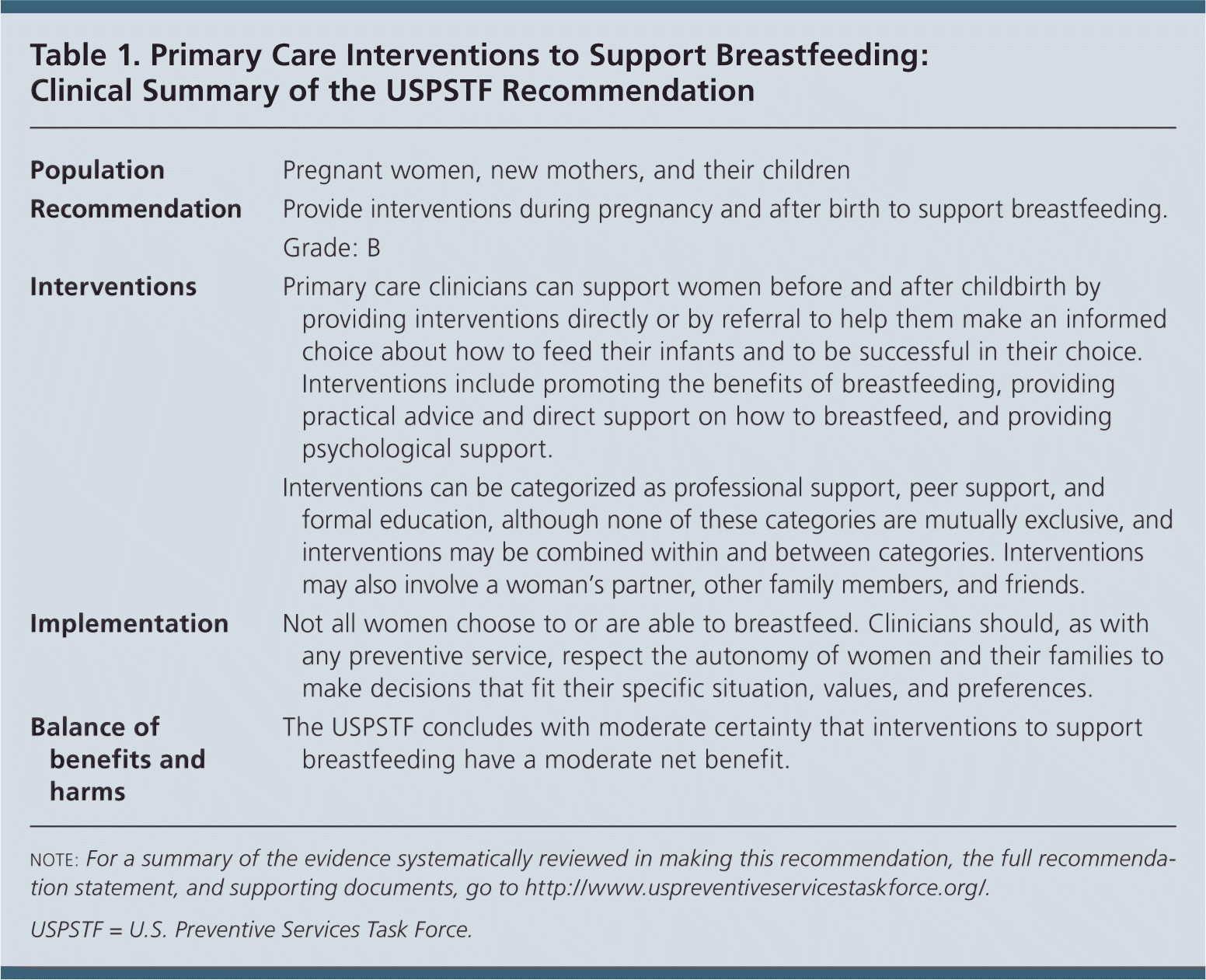
Am Fam Physician. 2017;95(8):online
Related Putting Prevention into Practice: Primary Interventions to Support Breastfeeding.
As published by the U.S. Preventive Services Task Force.
Summary of Recommendation and Evidence
The USPSTF recommends providing interventions during pregnancy and after birth to support breastfeeding (Table 1). B recommendation.

| Population | Pregnant women, new mothers, and their children |
| Recommendation | Provide interventions during pregnancy and after birth to support breastfeeding. |
| Grade: B | |
| Interventions | Primary care clinicians can support women before and after childbirth by providing interventions directly or by referral to help them make an informed choice about how to feed their infants and to be successful in their choice. Interventions include promoting the benefits of breastfeeding, providing practical advice and direct support on how to breastfeed, and providing psychological support. |
| Interventions can be categorized as professional support, peer support, and formal education, although none of these categories are mutually exclusive, and interventions may be combined within and between categories. Interventions may also involve a woman's partner, other family members, and friends. | |
| Implementation | Not all women choose to or are able to breastfeed. Clinicians should, as with any preventive service, respect the autonomy of women and their families to make decisions that fit their specific situation, values, and preferences. |
| Balance of benefits and harms | The USPSTF concludes with moderate certainty that interventions to supportbreastfeeding have a moderate net benefit. |
Rationale
IMPORTANCE
There is convincing evidence that breastfeed-ing provides substantial health benefits for children and adequate evidence that breast-feeding provides moderate health benefits for women. However, nearly half of all mothers in the United States who initially breastfeed stop doing so by 6 months, and there are significant disparities in breastfeeding rates among younger mothers and in disadvantaged communities.1
EFFECTIVENESS OF INTERVENTIONS TO CHANGE BEHAVIOR
Adequate evidence indicates that interventions to support breastfeeding increase the duration and rates of breastfeeding, including exclusive breastfeeding.
HARMS OF INTERVENTIONS TO CHANGE BEHAVIOR
There is adequate evidence to bound the potential harms of interventions to support breastfeeding as no greater than small, based on the nature of the intervention, the low likelihood of serious harms, and the available information from studies reporting few harms.
USPSTF ASSESSMENT
The USPSTF concludes with moderate certainty that interventions to support breastfeeding have a moderate net benefit for women and their children.
Clinical Considerations
PATIENT POPULATION UNDER CONSIDERATION
This recommendation applies to pregnant women, new mothers, and their infants and children. Interventions to support breastfeeding may also involve a woman's partner, other family members, and friends. This recommendation does not apply in circumstances where there are contraindications to breastfeeding (e.g., certain maternal medical conditions or infant metabolic disorders, such as galactosemia). The USPSTF did not review evidence on interventions directed at breastfeeding of preterm infants.
INTERVENTIONS
Breastfeeding support can begin during pregnancy and continue through the early life of the child. Primary care clinicians can support women before and after childbirth by providing interventions directly or through referral to help them make an informed choice about how to feed their infants and to be successful in their choice. Interventions include promoting the benefits of breastfeeding, providing practical advice and direct support on how to breastfeed, and providing psychological support. Interventions can be categorized as professional support, peer support, and formal education, although none of these categories are mutually exclusive, and interventions may be combined within and between categories.
Professional Support. Professional support is 1-on-1 counseling about breastfeeding provided by a health professional (medical, nursing, or allied professionals, including those providing lactation care). Some interventions include the provision of supplies, such as educational materials, nursing bras, and breast pumps. Professional support can include providing information about the benefits of breastfeeding, psychological support (encouraging the mother, providing reassurance, and discussing the mother's questions and problems), and direct support during breastfeeding observations (helping with the positioning of the infant and observing latching). Professional support may be delivered during pregnancy, the hospital stay, the postpartum period, or at multiple stages. It may be conducted in an office setting, in the hospital, through home visits, through telephone support, or any combination of these. Sessions generally last from 15 to 45 minutes, although some programs have used shorter or longer sessions. Most successful interventions include multiple sessions and are delivered at more than 1 point in time.
Peer Support. Similar to professional support, peer support provides women with 1-on-1 counseling about breastfeeding but is delivered by a layperson (generally a mother with successful breastfeeding experience and a background similar to that of the patient) who has received training in how to provide support. Like professional support, peer support may be delivered through a variety of stages, settings, methods, and durations.
Formal Education. Formal education interventions typically include a formalized program to convey general breastfeeding knowledge, most often in the prenatal period, although some may span time periods. Education is usually offered in group sessions and may include telephone support, electronic interventions, videos, and print materials. They are directed at mothers but may include other family members. Content generally focuses on the benefits of breastfeeding, practical breastfeeding skills (e.g., latching), and the management of common breastfeeding complications; these programs may also offer family members encouragement and advice on how to support the mother.
USEFUL RESOURCES
This recommendation statement was first published in JAMA. 2016; 316(16):1688–1693.
The “Other Considerations,” “Discussion,” “Update of Previous USPSTF Recommendation,” and “Recommendations of Others” sections of this recommendation statement are available at https://www.uspreventiveservicestaskforce.org/Page/Document/UpdateSummaryFinal/breastfeeding-primary-care-interventions.
The USPSTF recommendations are independent of the U.S. government. They do not represent the views of the Agency for Healthcare Research and Quality, the U.S. Department of Health and Human Services, or the U.S. Public Health Service.
